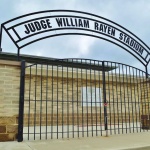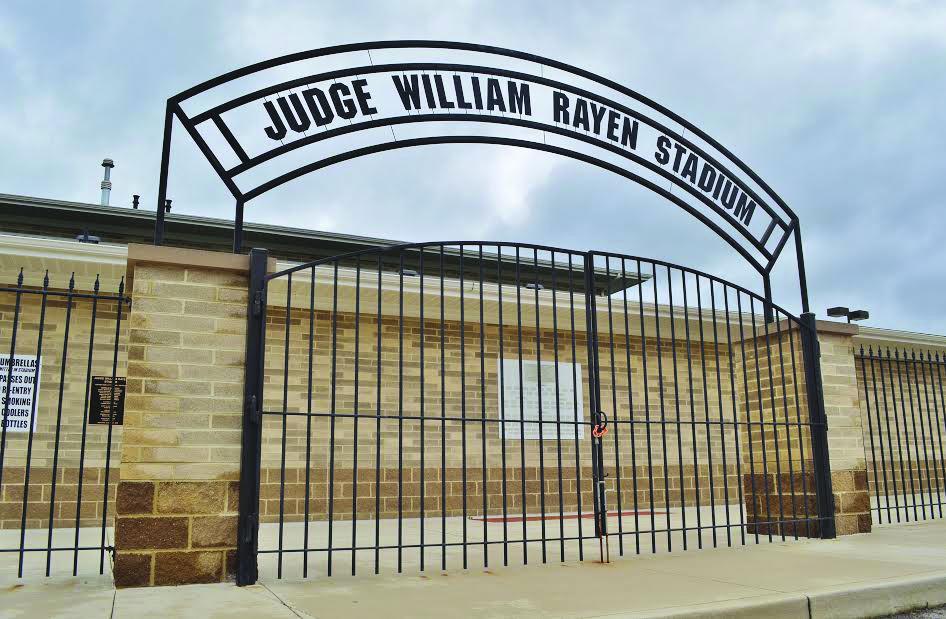By Dan Hiner

It doesn’t take long to realize Youngstown’s football roots run deep. Sitting in the heart of the Mahoning Valley, on the north side of the city, lies Rayen Stadium — once the mecca of Youngstown football.
Built in 1924, Rayen Stadium was the home for almost all high school football teams in the city during the first half of the 20th century. Jim Tressel, Youngstown State University’s president, remembers when YSU football’s home was Rayen Stadium.
“YSU used to play at the stadium. Before we had Stambaugh Stadium, we used to play our games at Rayen,” Tressel said. “It’s had a tremendous history for both high school and college football.”
History was made at Rayen Stadium over the years. State champions were crowned; future college and professional players took center stage. Even the infamous penalty flag made its debut in the stadium at YSU’s home game against Oklahoma City University on Oct. 17, 1941.
The YSU football team played at Rayen Stadium from 1938-69 and later from 1974-77. Former NFL players like Al Campana, Craig Cotton and Ralph Goldston graced the field during the ‘50s and ‘60s. YSU’s current field, Stambaugh Stadium, was built in 1982, and the Penguins ceased playing on the North Side.
Eventually high school football programs gravitated toward the allure of Stambaugh Stadium in downtown Youngstown, and high schools stopped playing football games consistently at Rayen following the 1993 season.
After decades of games, the historic facility was left vacant after a final game between Rayen and Akron East High School in 2005.
“They [Youngstown high school football teams] played at YSU a little bit, but that was a little bit big for them, and it was a little bit too expensive for the size of the crowds,” Tressel said. “They were playing games on the road all of the time. I felt that in order to create that community spirit, that school spirit and the spirit for the teams, here we had this historic stadium that was very capable of being renovated, that had lots of history and it could turn into a place where the neighborhoods could walk to the games and would be a great thing for the community.”
Tressel was one of many advocates for the reuse of the stadium. Tressel and Lewis Macklin were named the co-chairs of the Rayen Project, a community-wide effort to restore the stadium before the 2012 season.
“I was approached by one of the athletic directors of one of the city schools,” Tressel said. “Maybe around 2008 or so, and they came to the conclusion that Stambaugh Stadium was a little too large and expensive for them, and they wanted to see if they could renovate one of their existing facilities, and I told them that I would be more than happy to help.”
After some back-and-forth discussions with the city of Youngstown, Rayen Stadium was eventually renovated and renamed Jack Antonucci Field. Antonucci was a former Rayen football player who was selected to the all-city team in the 1930s.
Edward Matey, the Youngstown City Schools athletic director, said the restorations to the field and seating provided a complete makeover. Approximately $3.2 million was spent on the repairs.
Tressel said simply having a home stadium for high school athletics can have a major impact on not only the football team, but the community as a whole.
“I think it’s real important, and not just for high school football, but the band needs some place to practice, the youth leagues can have somewhere to practice. I know Ursuline [High School] has used it for [junior varsity] games because it is close by,” Tressel said.
Tressel said he thought it was important for the spirit of the community and the North Side.
“I think it’s important that a 3rd grader, when they’re walking to school and they walk by that stadium, dreaming about marching in the band on that field, playing football on that field, or soccer,” Tressel said. “Someday it would be fun for that field to have artificial turf so it could get even more use.”
After sitting unused for seven years and falling into disrepair, the stadium reopened in September 2012, and hosts the East High School football team — a combination of Youngstown high school football teams formed when the city decided to consolidate the athletic programs in the Youngstown City School District.
P.J. Mays, head coach of the East High School football team and former YSU All-American running back, said current players on the East roster are too young to understand the relevance of their home stadium.
“Our kids actually don’t grasp the fact of what Rayen Stadium actually means. To them it’s just our home stadium,” Mays said. “For them, as far as the historical stadium, they really don’t understand the meaning of Rayen field, and why they decided to renovate Rayen Stadium as opposed to any of the other venues they could have used in the city. Our guys really don’t understand that. They just feel lucky that they have a place close to home that is theirs.”
Mays and his coaching staff try to educate the team on the Rayen Stadium and the historical significance of football in Youngstown.
“Anytime we possibly can, we try to incorporate the people of the past or anyone that’s still around that has a story to tell about Youngstown’s great past as far as Rayen Stadium or Youngstown College [previous name of YSU],” he said. “We definitely try to bring those people in to educate our kids on what they have, or what previous generations did not have.”
Mays said the fans and players are happy with the restoration of the field, and even though the previous generation never had an opportunity to call Rayen Stadium their home, the current players and coaches are trying to bring a winning tradition back to their former football mecca.
“One of the things that we preached at the end of [last] year was we need to create a home field advantage at Rayen Stadium. That’s our home. That’s kind of the approach that we try to take with our guys starting this year,” Mays said.
“When we’re at home, it’s our place, and we play our best football at home and make it a place where other people don’t want to come and play us. They’re trying to get that sense about themselves. Where the East High Panthers play, at Rayen Stadium, and when you go there you are in for a great battle.”
